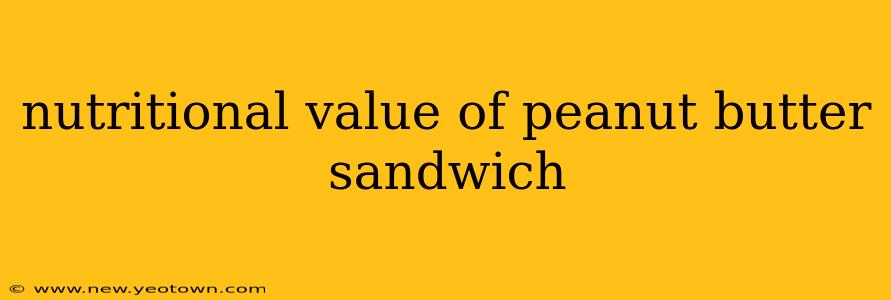The Unexpected Nutritional Powerhouse: Unpacking the Peanut Butter Sandwich
The humble peanut butter sandwich. A childhood staple, a quick lunch, a late-night snack – it’s a food that evokes comfort and nostalgia for many. But beyond its simple appeal lies a surprising nutritional profile that deserves a closer look. This isn't just about childhood memories; we're diving deep into the vitamins, minerals, and overall health benefits packed into this everyday classic.
Let's embark on a journey to uncover the nutritional value, exploring everything from its protein content to its potential impact on your overall well-being. We'll even tackle some common questions surrounding this beloved treat.
How many calories are in a peanut butter sandwich?
The calorie count of a peanut butter sandwich is highly variable, depending on several key factors. The size of the bread, the amount of peanut butter used, and even the type of bread all contribute to the final number. A typical sandwich made with two slices of white bread and two tablespoons of peanut butter can range from 250 to 400 calories. Opting for whole-wheat bread and reducing the peanut butter slightly can help lower the calorie count while retaining the nutritional benefits. Always check the nutritional information on your specific ingredients for the most accurate assessment.
What are the macro and micronutrients in a peanut butter sandwich?
A peanut butter sandwich is a surprisingly good source of several essential nutrients. Let's break down the macros and micros:
-
Macronutrients: This powerhouse provides a decent amount of protein, thanks to the peanut butter, which helps with satiety and muscle building. Carbohydrates, mainly from the bread, provide energy. And, of course, there's fat – mostly healthy fats from the peanuts, contributing to heart health and hormone production. The exact macronutrient breakdown will depend on your specific ingredients.
-
Micronutrients: Peanut butter is a good source of vitamin E, a potent antioxidant. Peanuts also contribute magnesium, potassium, and several other minerals essential for various bodily functions. The bread, particularly whole-wheat bread, adds fiber, further boosting digestive health.
Is a peanut butter sandwich a healthy snack?
Whether a peanut butter sandwich qualifies as a "healthy snack" depends largely on context and ingredients. A sandwich made with whole-wheat bread, a moderate amount of natural peanut butter (avoiding added sugars and hydrogenated oils), and perhaps a few slices of banana or apple can be a nutritious and satisfying option. However, a sandwich loaded with processed white bread, excessive amounts of sugary peanut butter, and unhealthy additions becomes less beneficial. Moderation and ingredient selection are key here.
What are the health benefits of eating a peanut butter sandwich?
Beyond the macronutrients and micronutrients, a well-made peanut butter sandwich can contribute to several health benefits:
- Improved Heart Health: The healthy fats in peanut butter can contribute to lower cholesterol levels.
- Increased Energy Levels: Carbohydrates from the bread provide sustained energy.
- Better Digestive Health: Fiber from whole-wheat bread supports gut health.
- Muscle Building & Repair: Protein from peanut butter aids in muscle growth and repair.
- Stronger Immune System: Vitamin E, found in abundance in peanuts, is crucial for a robust immune system.
Can a peanut butter sandwich be part of a balanced diet?
Absolutely! A peanut butter sandwich can easily be incorporated into a balanced diet, especially as a convenient and nutritious snack or part of a meal. Remember to choose wisely regarding your bread and peanut butter selection to maximize its nutritional benefits and minimize the potential downsides of added sugars and unhealthy fats.
In Conclusion:
The nutritional value of a peanut butter sandwich is far more nuanced than its simple appearance suggests. By being mindful of the ingredients and making conscious choices, you can enjoy this classic treat while reaping its numerous health benefits. This isn't just a nostalgic comfort food; it’s a surprisingly versatile and nutritious addition to a balanced diet.

